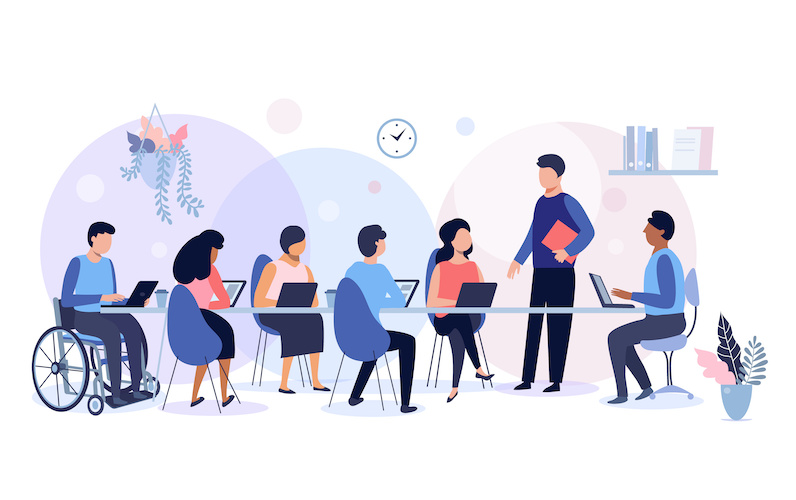Learning leaders can often make the mistake of thinking too narrowly about “inclusion.” For most CLOs and learning leaders, the word inclusion is synonymous with diversity, and diversity has become synonymous with the differences that you can see. As a result, learning leaders will create great diversity and inclusion training programs that focus on things like unconscious bias, understanding differences and cultural norms. While I’m not saying that those things aren’t valuable, they don’t fulfill the basic goal of inclusion.
The best description that I have heard about what inclusion really means came from a discussion I had recently with my friends at Merit America. They define inclusion as “finding dignity in your work and being able to live your purpose by knowing that your contributions are wanted, sought after and valued.”
So, if that’s what we are trying to achieve with our inclusion initiatives, how can we develop a learning strategy that is, in itself, inclusive?
6 ways to think about inclusive learning
To ensure all employees feel valued and included in your learning practices and solutions, I would recommend you incorporate these six things into your learning strategy. I call them the six A’s:
- Access to learning
- Adaptable learning delivery
- Agency through a diverse skills portfolio
- Affiliation by learning with others
- Amplifying power skills by focusing on inclusive skills
- Accountability for applying learning to deliver results
Access to learning
An inclusive learning environment empowers all employees to have access to learning when and where they need it. Learning leaders must make learning content and solutions available to learners 24 hours a day, seven days a week, on site, on a computer and through mobile devices to ensure that learners can learn when it works for them. If needed, you may also consider providing infrastructure so people can access learning from their workplace or home. Vale, for example, provides internet on its ships and down its mines, as well as mobile access for its truck drivers so everyone can log on to their learning.
Additionally, providing inclusive access hinges on providing learning opportunities in a language that each individual understands. Therefore, learning should be provided in a variety of languages to ensure learners can consume content in the language they are most comfortable with. This may include sign language or subtitles for video and audio recordings, or braille.
Improving access also involves meeting the needs of employees who have additional needs, providing tailored tools and processes to help them learn and track their learning. Neurodiverse individuals, for example, may learn best with visual lists or social stories to set expectations for in-person learning.
Adaptable learning delivery
Everyone learns differently, but we are often only offered a one-size-fits-all approach for delivering learning on a particular topic. To create an inclusive learning environment, you must first acknowledge that people need options that reflect how they acquire knowledge, develop skills, and activate those skills and knowledge.
The first step in this process is to help employees understand how they learn best. Are they auditory learners, visual learners, reading/writing learners or kinesthetic learners? Next, ensure you provide different options so each individual can select the learning experience that works best for them.
Build agency through a diverse skills portfolio
In today’s environment, most companies are focused on skills as a means of preparing employees to perform better in their current role and grow into their future career. However, learning leaders don’t do enough to teach their employees that in order for them to remain competitive in the workplace today and achieve career elasticity for the future, they must build a skills portfolio that consists of a diverse set of skills.
I like to see a skills portfolio as being composed of three types of skill categories: power skills, functional/technical skills and hot skills.
Power skills are those durable skills that can be easily applied in any job. We often call these soft skills or professional skills, but they are power skills due to their long shelf life and adaptability.
Functional and technical skills are those that require subject-level knowledge and expertise (e.g., marketing, sales, product, finance, etc.). While these skills require an individual to gain a deeper understanding of a specific subject area, many of the skills can also be transferable under the right conditions. I call these situational skills. These skills have the most value under the right conditions and situations.
Hot skills are the skills that are in demand at a specific point in time. These skills usually offer the highest market value due to their criticality in the execution of business strategy and their limited availability in the marketplace. These skills also have the shortest shelf life and therefore can be retired or evolved within a few years. Employees must continuously upskill and reskill in this category for their hot skills to remain current.
Create affiliations with a supportive learning environment
Learning leaders know that in order for individuals to retain what they have learned, they must be given opportunities to reinforce their learning. As such, organizations must create a supportive learning environment that provides employees with the opportunities to reinforce and practice their new knowledge and skills.
Here are a few ways you can create a supportive learning environment:
- Provide opportunities to learn in the flow of work through projects, special assignments and work streams.
- Establish working squads with individuals who have different functional/technical skills and hot skills. Working squads allow peers to learn new skills from each other while also reinforcing the skills they have acquired.
- Teach employees to turn learning into a habit. Teach them easy ways to set goals for daily learning. Ask employees to spend five minutes a day learning something new or deepening their knowledge by reading an article, watching a video or listening to a podcast. When employees actually track these microlearning activities over time, they will discover that they are more engaged in the learning process than they believed.
- Encourage employees to teach someone else something that they know well or have just learned. The best way to demonstrate that you have mastered what you have learned is to teach it to someone else. In medicine they have a saying: “See one, do one, teach one.” This same principle should be applied in corporate learning.
Amplify power skills by focusing on inclusive skills
Inclusive skills are the skills we use to create an inclusive work environment. Interestingly, inclusive skills aren’t new; they are some of the most common power skills that we use on a regular basis. However, if you want to optimize the effectiveness of these skills, you need to bundle the skills together and teach employees and managers how to effectively leverage them to create a more inclusive environment.
At Degreed, we are in the process of conducting our own research (due out in late Q3) into the most powerful inclusive skills. However, early indications are pointing to those below:
- Active listening
- Feedback
- Collaboration
- Expansive questioning
- Problem-solving
- Simplifying
- Empathy activation
Drive accountability for applying learning to deliver results
At the end of the day, both employees and learning professionals are accountable for ensuring the knowledge and skills that are acquired over time are applied to perform meaningful work to deliver business outcomes.
Employees should be held accountable for building the skills that matter most and leveraging those skills so they perform well in their daily work activities. More important, organizations should be held accountable for creating the conditions and providing the resources that allow employees to grow and thrive in their work and careers.
Learning for all employees
Now is the time to look long and hard at your learning strategy to ensure its approaches, practices and solutions are providing all employees with a safe, comfortable and dignified learning experience. This enables all employees to optimize their contributions and value, bringing their best selves to their work.















